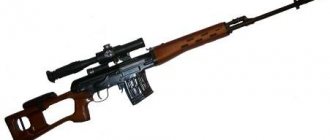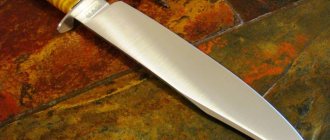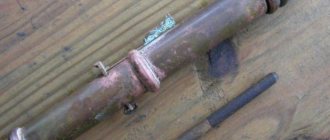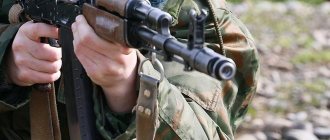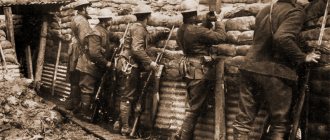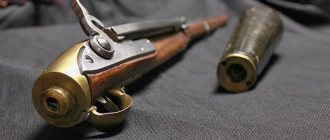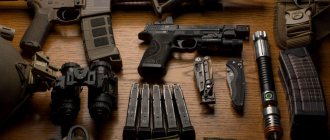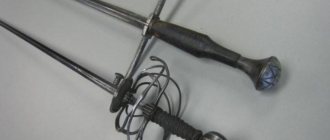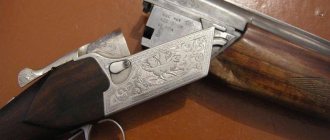The use of weapons and the use of weapons: general concepts, similarities and differences between terms. In legal practice there are many terms that are closely related in meaning. But this is only at first glance; upon detailed and step-by-step familiarization with their interpretation, it becomes obvious that in fact, these concepts are clearly distinguished and have an exclusive meaning for themselves, being applied in various situations. This also happens with understanding the cases when it is appropriate to use the phrase “use a weapon” and when to “use a weapon.” To do this, you need to analyze their definitions and the scope of their application.
General concepts
The terms “use” and “use” a weapon refer directly to the actions performed with that weapon. Like any actions, they have a subject and an object, a motive and conditions for their application. Legislation regulates the use and use of weapons:
- Citizens - Article 24 of the federal law “On Weapons”.
- Police officers – Articles 23 and 24 of the Federal Law “On the Police”.
- Military personnel – Articles 13 and 14 of the Charter.
According to these regulatory documents, the subject of the use or use of weapons is a person acting to avoid the development of a situation that poses a danger to society or to his personality. Or this application and use is aimed at eliminating it. The objects for each action are not always the same. The motives and conditions will also have features for each type. To understand how these terms—actions—differ, you need to understand how they are similar.
What is a traumatic weapon from the point of view of the law?
According to the current legislation of the Russian Federation, civilian models of pistols of various designs intended for self-defense of citizens are considered traumatic or limited-damage firearms. A traumatic weapon may have the following distinctive characteristics:
- Ammunition for traumatic weapons uses a rubber bullet as a striking element, which is not capable of causing serious injuries. Thus, OOOP is designed to temporarily incapacitate the attacker, allowing the defender to escape the scene of the attack.
- The use of a traumatic pistol is permitted only for self-defense purposes. It is for this purpose that various teaching materials have been developed and are available at training centers for shooting such weapons.
- The muzzle energy of traumatic ammunition is limited to 91 Joules - sufficient to cause severe pain and temporarily incapacitate the enemy, but not enough to cause serious damage.
- The magazine capacity of a traumatic pistol is limited to ten charges.
- OOOP should not be able to use solid-state ammunition and conduct automatic fire.
Self-defense weapons can be carried with you and used if necessary only if you have the necessary permits - a license to purchase and carry weapons.
Similarities
The similarity between application and use lies in the fact that one is impossible without the other. After all, in order to use a weapon, that is, shoot, you need to use it, that is, carry it with you, take it out, aim, etc. To use means to interact with the weapon, right up to its use. But the concept of applying has rather narrow boundaries of understanding. And this will be their main differences.
Defense against attack
The use of firearms by the police is permitted if there is a threat to the life or health of citizens, both civilians and those in the ranks of the Armed Forces. At the same time, it must be stated that it is impossible to protect these persons by other means. The conditions of necessary defense cover this situation, if we exclude from it a threat to health. It does not allow defensive actions aimed at causing death. The indication in this provision of other methods of ensuring protection limits the scope of the legality of the necessary defense, provided primarily in Art. 37, part 1 of the Criminal Code. According to experts, adding to the order the phrase “if it is not possible to achieve protection by other means” is legally redundant.
Differences
Police officers, military personnel or citizens with appropriate permission, depending on the situation, use weapons for:
- Protecting yourself or another person from dangerous acts of third parties if it involves a risk to life.
- Protection from attacks on military equipment and weapons.
- To repel group and armed attacks on public and government facilities.
- To detain armed persons who are actively resisting, posing a threat to the life and health of others.
It is not necessary to consider all cases of the use of weapons in order to trace the analogy that weapons are used in extreme situations associated with a critical public and state danger. The subject of the use of weapons is a person. Weapons are used to cause harm to health. Whereas it is used in cases aimed at eliminating the conditions for creating such situations and in some others:
- To detain and stop a vehicle if the person driving it refuses to do this voluntarily, creating a threat to others by his actions.
- To neutralize an aggressive animal that poses a threat to the population.
- To warn about the use of weapons.
- For hunting, shooting in entertainment and educational institutions, etc.
- For demo shows.
This is also not a complete list of weapon uses. The main thing that can be highlighted is the objects of use; they can be varied . But the object of use will never be human life and health. Weapons can also be used for peaceful purposes.
Based on the above, it should be noted that the concept of “use” of a weapon is broader in relation to the concept of its “use” and includes it. The motives and conditions for the use or use of weapons are differentiated according to the degree of danger and the current situation. As a result, there will be disagreements in the legal and political arenas regarding the correctness of their use in practice.
JurisprudenceComment
In what cases can traumatic weapons be used?
A traumatic pistol is allowed to be used only in certain cases - when the life and health of the owner or his loved ones, as well as his property, are in real danger.
The main goal of OOOP is to prevent a serious offense, and not to create it, so the defender must clearly understand the line where he can shoot - between necessary self-defense and an attempt on life and health.
It would be appropriate to use a traumatic pistol against an armed aggressor who poses a real threat to the owner of a weapon of limited destruction. At the same time, according to the legislation of the Russian Federation, the shooter must first warn the aggressor, and also, if possible, fire a warning shot in the air. Only after this is it allowed to open fire on the target at permissible firing distances.
Prohibitions
They are established in Art. 14, part 4 UVS. In accordance with the norm, the use of weapons in relation to:
- Minors, when age is known or obvious.
- Women.
- Citizens with obvious (external) signs of disability.
The exception is situations when these persons commit a group or armed attack that creates a threat to other persons. The use of weapons in such cases is permitted if it is not possible to eliminate the danger posed by them by other means.
Unlike Art. 28, Part 3 of the Federal Law regulating the activities of internal troops, the specified prohibitions lack a number of provisions. In particular, there is no indication of the armament of the resistance and the non-use of weapons in large crowds of citizens. Meanwhile, for the sake of completeness of the analysis, it must be said that the above exceptions that abolish the prohibitions cannot cover the entire breadth of situational diversity, when a threat to life from attacks by disabled people, women and minors may manifest itself in others different from those established in Art. 14, part 4 UVS forms. This, in turn, means that military personnel have the right to use weapons against specified subjects in situations that go beyond the restrictions provided for in the norm. In this case, there must be a danger to life if they attack in any other form.
Shotgun selection
At the moment, there are several types of shotguns, which are classified according to the structural features of the barrel and the loading method. Regarding the first criterion, the following types of guns are distinguished:
- Smoothbore. Such guns can be called classic, since they appeared the very first. A smoothbore gun is used to fire shot, special bullets and buckshot. It is aimed at hitting targets at short and medium distances. The most famous representative of this type of weapon is the shotgun.
- Rifled type. It includes rifles (the name comes from the word “screw”, which in itself indicates the structure of the barrel), carbines and fittings. The presence of threads inside the barrel allows the bullet to spin, as a result of which such weapons are intended for long-range shooting.
The procedure for obtaining permission to store and use rifled weapons is quite complicated. In particular, a beginner will not be able to get such a weapon at his disposal, since it is allowed to be used only five years after purchasing a smoothbore gun.
Regarding the charging method, it is possible to divide smooth-bore weapons into two types:
- Models with folding trunks. They are the most popular among hunters.
- With non-retractable trunks. These are guns with a magazine and a built-in mechanism for replacing the spent cartridge case.
Models with folding barrels
The double-barreled shotgun is the most popular unit for hunting, famous for its shooting comfort and practicality.
People call them “fractures.” They are easy to load, as you just need to insert the cartridge into the chamber. There are no additional cartridge feeding mechanisms here, which makes this design as reliable as possible. Experts believe that there is simply nothing to break here; moreover, such structures do not require special maintenance, and therefore are an excellent choice for beginners.
Shotguns with flip-up barrels are divided into two types:
- Kurkovki. For such models, the trigger is located outside. These are high-quality and very reliable guns, which are currently produced in limited editions, and therefore are quite expensive. Today they are purchased mainly by connoisseurs.
- Beskurkovki. Models of the internal trigger type, which have a more complex mechanism. These modern guns are often chosen for self-defense and hunting.
To remove spent cartridges, such weapons have an ejector or extractor. The latter involves removing the cartridge case by hand, while the ejector ejects the cartridge case using a special spring.
When choosing a smoothbore gun, you should take into account that extractor models are simpler in design, easier to maintain and less prone to breakdowns. However, they are inferior to ejector guns in terms of rate of fire. The extractor also allows you to collect spent cartridges for reuse.
Regarding the number of trunks, the following types of “fractures” are distinguished:
- Single-barreled shotguns. They are relatively cheap, simple and lightweight designs. An ideal choice for a beginner. Such guns have high combat accuracy.
- Double-barreled shotgun. Perhaps the most popular type of gun, which is especially loved by hunters. Both horizontal and vertical mounting of trunks is possible. The latter option is more popular due to its high accuracy and convenience.
- Three- and four-barreled guns. Such models can be represented by both smooth and rifled barrels. However, they did not gain high popularity.
Shotguns with non-retractable barrels
Pump-action shotgun models are very popular these days.
Repeating shotguns are equipped with their own magazine and a built-in mechanism for replacing spent cartridges. Such a mechanism can be represented by a bolt shutter or have automatic recoil.
Compared to the previous type of shotgun, these models have the following advantages:
- high combat power;
- ease of use;
- rate of fire.
Among the main disadvantages are the following:
- setting up mechanisms requires high qualifications;
- the design is afraid of contamination, and therefore hunters rarely choose it;
- There are special requirements for lubricants and cartridges.
Pump-action models are very popular nowadays. They are easy to use, since in this case there is no need to change hand positions to reload. Given this feature, a pump-action shotgun can be an excellent means of self-defense. It has a high rate of fire, is not demanding on the type of cartridges and is easy to maintain. To all these advantages should also be added high power.
Additionally
The law establishes prohibitions for gun owners regarding their carrying. In particular, it is not permitted if:
- The person is intoxicated.
- The subject participates in a meeting, rally, procession, demonstration, picketing, religious ceremony or rite, sports, cultural, entertainment or other public event.
There is an exception for the last case. This rule does not apply to:
- Persons who directly participate in competitions using sports weapons.
- Cossacks who are at meetings of their societies, participating in religious ceremonies and rituals, cultural and entertainment events associated with the mandatory wearing of a national costume, in territories where the presence of bladed weapons is an integral part of it.
- Subjects authorized to ensure public safety and order of citizens.
Persons acting as organizers of cultural, sports and entertainment events have the right to temporary storage of weapons belonging to citizens in the manner prescribed by the Federal Law.
Hatsan Escort AimGuard (Türkiye)
Positioned by the manufacturer as a self-defense weapon. It is distinguished by good reliability and decent workmanship at a low cost. Caliber 12/76 mm. Barrel length - 450 or 500 mm. Magazine capacity - 5 or 7 rounds. The handguard and butt are plastic.
There are options with a metal folding stock and a pistol grip, and with a pistol grip without a stock.
A pump-action shotgun is a formidable and effective weapon for self-defense. It is suitable for solving most problems of ensuring the safety of yourself and your family, as well as your territory.
Watch a video review of a pump-action weapon, an expert will tell you how a pump differs from a semi-automatic weapon and a lot of other useful information for choosing a shotgun:
